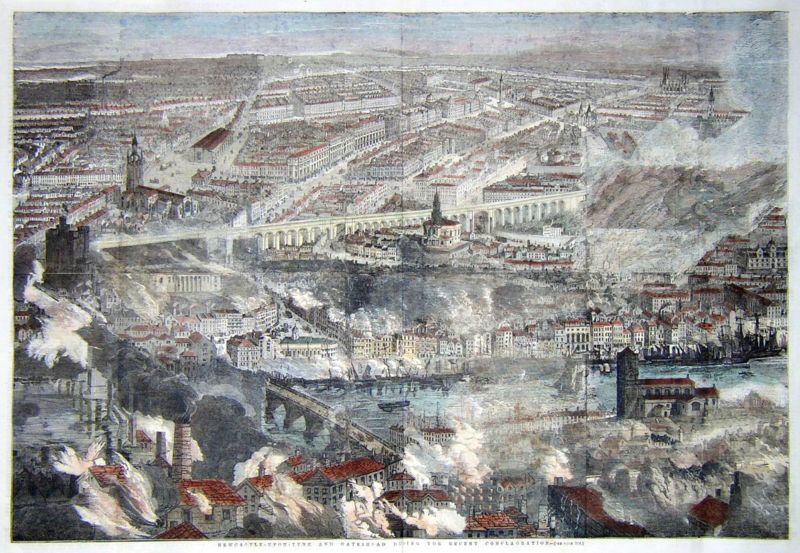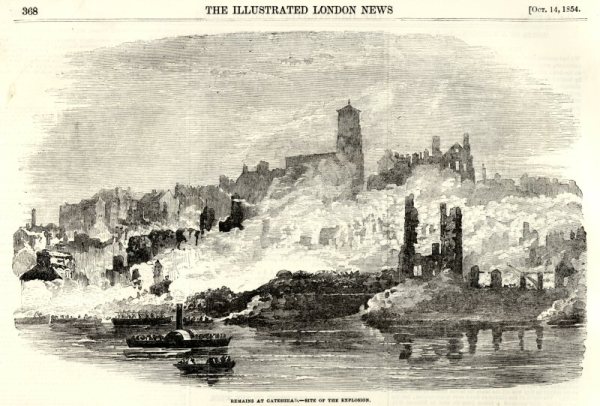This is a six-stage multicache that will take you along the devastating path of the Great Fire of Newcastle and Gateshead, an inferno that destroyed a substantial amount of property in a series of fires, culminating in an explosion that killed 53 and injured hundreds.
1. The Warehouse Fires
N 54° 58.038
W 001° 36.293
Shortly after midnight on October 6th 1854, a fire was discovered in the upper section of the Wilson and Sons worsted mill where you are now standing. The majority of the goods within the mill were stored at ground level, but despite attempts by the North British and Newcastle fire engines, the police, and the rapidly gathering crowds, the fire spread throughout the mill. Fueled by the large quantities of oil stored around the premesis, the fire quickly engulfed the building and in less then an hour it was one mass of fire.
In the immediate neighbourhood of Wilson & Sons was a bond warehouse built twelve years previously by Charles Bertram. The building was extensive, reaching to seven storeys and capable of holding an immense amount of goods. It was at the time used to store thousands of tons of sulphur, nitrate of soda, and other combustibles. It was in part "a double fire-proof structure", with massive metal pillars and every due precaution against fire.
Despite this, the intense heat from the nearby worsted mill caused the sulphur to ignite, melt and stream in a burning blue liquidised state from the windows. The authorities, abandoning the mill, sought to save the warehouse, and directed all their efforts on it, with reinforcements from the military fire engine. This effort was thwarted by the wide scattering of burning brands from the fallen factory roof, which made the sulphur burn even more fiercely.
By 3am, the entire warehouse was one body of flames "most awfully magnificent". The sulphurous blaze illuminated the river and its shipping, the High Level Bridge, the Castle, the steeples of All Saints', St. Nicholas' and St. Mary's churches, and every prominent object, with a lurid purple light. From the various floors of the warehouse the sulphur flowed in torrents like streams of lava, and the building resembled "a cataract on fire".
The plaque at this location marks the site of Wilson's spinning mill where the fire began. The plaque was erected in 200A.

2. The Explosion
N 54° 58.041
W 001° 36.240
Such a large fire naturally attracted many spectators, who occupied every spot on the bridges, boats, quayside and surrounding buildings. A small bang was the first warning that there was something more perilous than sulphur alone in the burning pile. A second slight explosion did not warn the firemen and surrounding crowds. A third passed unheeded.
After a few minutes, a final explosion occurred. The vaults of the warehouse were burst open with a tremendous and terrific blast. Vessels on the river lifted as if lashed by a sudden storm. The old bridge shook, and the new quivered. Massive walls were crumbled into heaps, houses tumbled into ruins. The venerable parish Church of St Mary on the hill where you now stand, was shattered to a wreck, gravestones were broken and uplifted. The hands on the dial of its clock stood at ten minutes past three.
Thick black smoke rose as a "pillar of cloud" and for a moment all was silent;the scene lit by falling burning debris from the warehouse, then came the noise of collapsing buildings and then the cries of the injured.
Here you can see several stones that were thrown from the exploding warehouse. According to the plaque, how many cwt (the imperial equivalent of approximately 50kg) is the heaviest stone? Record this answer as B.
3. Bridge View
N 54° 58.076
W 001° 36.347
The projectile power of the explosion scattered burning debris widely across the river to Newcastle. The blast had even peeled off roofs as if to receive the "flaming rain". The High Level Bridge behind you provided an elevated platform for observation of the twin fires as they extended in Gateshead and Newcastle; the lower portions of the towns "took on the aspect of a burning cauldron". A mass of onlookers thronged the bridge watching the flames which rose from left and right, towering up and leaping from house to house, lane to lane, street to street.
The reverberation of the explosion was heard at North Shields, 10 miles away, where residents thought the shock was an earthquake. Gas lights in Jarrow were blown out. Debris from the fire was scattered across six miles of Gateshead and the surrounding areas. Miners in Monkwearmouth colliery, the deepest in the country at the time and eleven miles away, heard the explosion and came to the surface, wondering what had happened. Twenty miles westward at Hexham, 35 miles north at Alnwick and 40 miles south at Hartlepool the explosion was heard distinctly; as well as at over 20 nautical miles out to sea. The explosion crater was measured to have a depth of 40 feet (12 m), and a diameter of 50 feet (15 m).
The light of the flames could be seen, reflected in the sky, fifty miles away at Northallerton. And whilst the report of the explosion travelled so far, most people on the scene had no idea what had happened to them. They describe themselves as having been lifted from their feet and dashed down, the violence completely stunning them; and when they awoke in a stupor they had only the dim idea of a rolling sound in their ears.
From this vantage point you can see both the Newcastle and Gateshead quays, both of which were devastated in the 1854 fire. From the plaque at this location, note the year in which this bridge was opened. Record your answer as 19C8.

4. Akenside Hill
N 54° 58.207
W 001° 36.433
The force of the explosion was immense, and heavy debris was thrown as much as three quarters of a mile from its origin. Huge granite blocks forming the tramway for carts outside the warehouse were flung over St Mary's church for two and three hundred yards into neighbouring streets and buildings. One is recorded as falling 400 yards (370 m) away through the roof of the Grey Horse pub. A stone of 20 stone (127 kg) weight damaged property in Oakwellgate. Large blocks of wood and stone were projected widely over Newcastle, reaching the west end of the quayside.
A stone weighing 18.5 lb (8.4 kg) fell through the roof of an opticians in Grey Street; when workmen discovered it in the morning it was still too hot to touch. A timber beam, ten feet in length and weighing 3 cwt (150 kg) landed on the Ridley Arms in Pilgrim Street; and others on the roof of a house in Mosely Street.
A huge beam of timber, over six feet in length, was found on the roof of All Saint's Church next to where you now stand, in an area once known as Butchers Bank. From the noticeboard at this location, how many butchers's shops once occupied this area? Record your answer as D3.
5. The Newcastle Inferno
N 54° 58.144
W 001° 36.290
One hundred yards of street frontage-offices, shops and warehouses-were in a short time in flames, the conflagration running up the hill, Butcher Bank, to Pilgrim Street. A second conflagration, in a triangle bounded by Pilgrim Street, Butchers Bank and George's Stairs took hold. The entire combined strengths of the local fire brigades had been directed on the Gateshead properties and were, besides, buried beneath the rubble. So quickly did the fire move through the packed buildings that it was impossible to put out. This led to the devastation of several whole streets in this area, such as Plumbers chare, Hornsby's chare, Colman's chare, Pallister's chare and Peppercorn chare.
The buildings were not the only casualties. Some 53 people were accounted as having died, including Charles Bertram, owner of the exploding warehouse; and William Davidson, from the family who owned the factory. Figures for the injured are less reliable, but it is estimated that between 400 and 500 people were injured, some horribly, many receiving treatment at the Gateshead Dispensary and the Newcastle Infirmary. At the latter hospital, the beds of the existing in-patients were given to the newly injured, and the existing in-patients-where able-tended the new charges in their beds, under the direction of the medical staff.
You are standing at The Custom House, one of the few buildings along Newcastle's quayside that survived the fires. Despite this, its roof and all of its doors and windows were removed by the force of the explosion. The Custom House was built in 176E.

6. Cache Location
N 54 5(B+C).D(A+1)(B-E)
W 001 DE.E(C+D)A
The cache is located in Newcastle very near to where one of the furthest pieces of flying debris was found. The Courant newspaper office was hit by a stone from the explosion with such force that it penetrated the wall of the engine house. From the cache location you are facing back towards St Mary's Church where you began; from this distance, you can appreciate the massive destructive force of the Gateshead explosion.
You are looking for a magnetic nano and please be aware that when retrieving or replacing the cache you will be in full view of the nearby taxi rank so please use Maximum Stealth.
A comprehensive record of the Great Fire, written in 1855, can be found at this link.